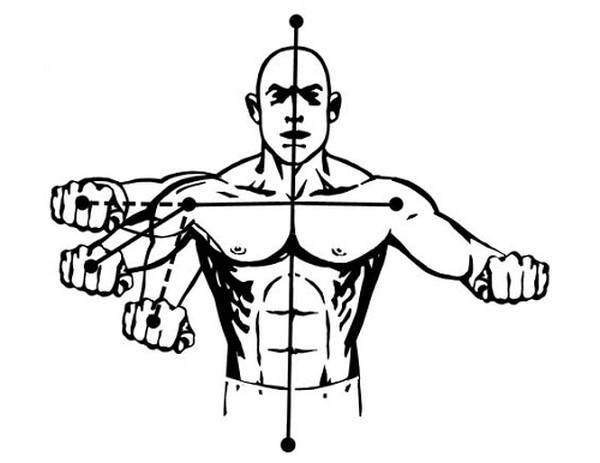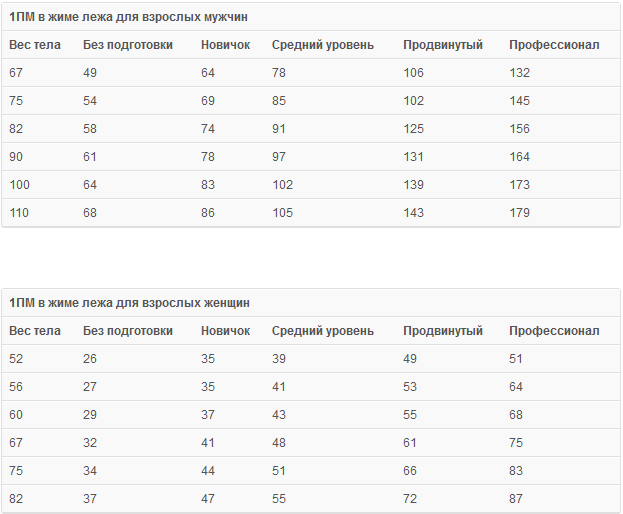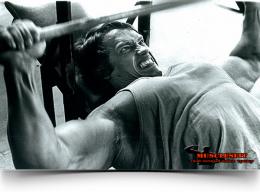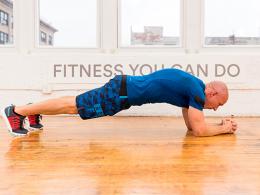All about the bench press
If you have been going to the rocking chair for quite a long time, then you have definitely been asked more than once "how much you press"? And, interestingly, you already know exactly what we are talking about - the maximum weight in the bench press.
The fact is that people are fascinated by the spectacle of lifting large weights from a prone position - which is why beginners in this business are often unhappy with their results, because they also want to catch respectful glances. But not only universal recognition leads people to include bench press in the training program - in fact, this exercise is extremely important for the development of the upper body (triceps, and pecs). This bench press indirectly affects the development of the legs, so it is stupid to underestimate it.
So, for starters, it is important to understand that the bench press is an exercise that must be performed strictly according to a certain technique, mistakes in this matter are fraught with unpleasant consequences (which, however, applies to any other exercise). If you do not understand what exactly and how you are doing, then sooner or later you will run into your “ceiling”. This article will just tell you how to competently and most effectively perform the bench press.
Fundamentals: theoretical and practical
What, in fact, is this bench press in the prone position? This is a basic (multi-joint) exercise that does not involve the use of any fixed weight, which is designed to increase the mass of muscle groups in the upper body, as well as to develop strength. Most of the load on the bench press goes to the pectoralis major muscle, but some of the load also goes to the deltoids and triceps.
There are several variations of the bench press:
1. The so-called "press to touch", which involves powerfully pushing the bar up immediately after it touches the chest.
2. Classic barbell bench press. It is performed lying on a horizontal bench, it is important to hold the barbell on outstretched arms. As with the press to the touch, the bar is lowered to a light touch of the chest, but after that a short pause is maintained, after which the neck is again squeezed into outstretched arms.
3. Bench press in the Smith machine. This simulator is generally quite a unique design - it allows you to perform most of the most basic exercises with maximum efficiency. The bench press is also possible to perform with this machine. To do this, you need to fix the guides and take a horizontal position on the bench, which must be prepared in advance for the exercise.
4. Bench press in the frame. The power rack also allows you to perform the bench press quite effectively. Take a position in the frame: the bar should initially be on the limiters, which must first be set at chest level, and then proceed to the exercise. As a rule, the bench press is used by athletes who have been injured and are now temporarily unable to use other bench press options (or there is simply no one to insure you).
5. Incline bench press. This version of the bench allows you to work out not only the upper part of the pectoral muscles, but also the lower one, which is very good.
In addition, in the bench press, you can direct the load to the desired muscle group, it all depends on the width of the grip of the bar. For example, a narrow grip has a stronger effect on the triceps, a wide grip on the middle of the chest.
Bench Press Technique
So, the equipment is prepared, you also warmed up - it's time for the bench press.
1. Take a position on the bench so that your eyes are exactly under the bar.
2. Next, lift your chest, squeeze your shoulder blades and press them against the bench. At this moment, you should feel tension in the upper back - this indicates the correct position, maintain this position throughout the exercise. Now you can grab the bar with a grip slightly wider than shoulder width.
3. Take the bar in the palm of your hand is closer to the wrists, and not to the fingers. Squeeze the bar as hard as possible. The wrists at this point should not be bent towards the head - they should be straight (in the future this will help you a lot, because you will thus avoid wrist pain).

If you're not sure about your grip width, ask someone to help you with that. Have your assistant stand behind you, looking down, assessing the position of the forearms - they should be perpendicular to the floor.
4. Now you need to slightly bend your lower back and place your legs at a right angle to your knees, shoulder width apart. Of course, your back will sag a little - this is normal, but do not overdo it.
Tip: Just maintain the natural curve of the body. As for the legs, they should stand confidently, not slip or move during the exercise. The muscles of the buttocks and thighs should also be tense, because. they will slightly lift you off the bench (remember, however, that there should be no separation of the pelvis from the bench).
5. Now it's time to remove the bar from the racks with straight outstretched arms. Once this has happened, move the bar in a horizontal line until it is exactly over your shoulders. Now, in fact, the "bench press" begins.
Repeat all of these movements whenever you're about to move on to the bench press during your workout - it'll help you get better technique, as well as get your body used to proper preparation. Naturally, this will also help avoid injury.
Weight Lowering Technique
In addition to lifting the weight, it is also important to understand how to lower it correctly, because. the load at this moment is quite serious. To begin with, remember that your elbows should be at an angle of 50-60 degrees in relation to the body - this is the most stable position for bench press. Many beginners spread their elbows out to the sides, or vice versa, press them too close to the body - both will sooner or later lead to injury, it is because of this that the bench press is considered one of the most dangerous exercises in terms of shoulder damage.
If, for example, in the lower phase of the press, the elbows are at an angle of 20-30 degrees, then this is considered too close, and 90 degrees is already too wide. So 60 degrees is considered the most optimal and safe position of the elbows in relation to the body.

We figured out the elbows, now you can return to the intricacies of the exercise. The bar must touch the chest, by all means avoid incomplete repetitions. Lower it at medium speed. The optimal lowering time is 2 seconds.
Lifting the bar and placing it on the rack
So, the neck touched the chest - it's time to press the barbell. Although the name of the exercise contains the word "bench", it is best to imagine that you are pushing the body away from the bar, and not vice versa. In the process of lifting, the neck should describe a small arc - from the chest to its original position. It is important to straighten your elbows, and not keep them slightly bent - this will help you keep the weight.

Remember that the shoulder blades during the bench press should always be brought together and pressed against the bench, there is a slight deflection in the lower back, the feet are firmly pressed to the floor, and the buttocks, respectively, are on the bench.
Theory: Bench Press Muscles
The muscles that participate in this exercise work not only in their normal mode (we are talking about physiology), but also in a rather specific one, developing a static effort. Simply put, they are concerned with stabilizing various parts of the body. The muscles that take on the load in the bench press can be roughly divided into 2 broad categories:
1. The main driving units that make the most significant contribution to the strength of the exercise. Otherwise they are called "direct movers". There is also another type of synergistic muscle, the "auxiliary movers", which work in the same direction as the main muscles to help move the limbs.
2. Engineering units. This type includes stabilizing muscles, which are responsible for the technically correct execution of the bench press - they fix the posture, as well as the position of all involved parts of the body with powerful efforts.

If you are clearly aware of which muscles work at each step of the exercise, you will be able to master it better, as well as develop an anatomical atlas of muscles. Of course, this will allow you to understand which muscles are lagging behind, increase strength and muscle volume without injury and overload. Now let's take a closer look at the contribution of the auxiliary muscle groups.
Step 1: Starting the exercise
Most beginners do not pay enough attention to the legs during the bench press, because it seems that the legs are not involved in the exercise. But in fact, this is not so - at the bottom point, the body resembles a spring, which helps to repel the bar. And if this spring is released too weakly, then you can forget about the further development of the chest - you will have to switch to strengthening the legs. Do barbell squats or deadlifts.
Step 2: Back
Many people get the impression that the main load during the bench press goes to the pectoral muscles and arms. But once you train your lower body enough and learn how to use it in the exercise, then you will feel that the back muscles have come into play. No wonder, because it is these muscles that accelerate the upward movement of the neck and allow you to make more powerful pushes. So do not forget about the development of back muscles - use block simulators and master the pull-up technique.
Step 3: Shoulders
Feel your optimal rhythm and pace of movement of the bar during the bench press and keep it in every workout. Don't rush, control every move. In addition, work on strengthening your shoulders, because they help maintain stability when lifting heavy loads, and also protect muscles from damage. One of the best shoulder exercises is considered to be a military bench press, it is recommended to add it to your program.
Step 4: Completing the Exercise
Develop triceps, otherwise you will not be able to smoothly and calmly bring the barbell to the top position. You can train your long head with French presses, do block extensions.
Bench press: types and methods of execution
The traditional barbell bench press is a must-have exercise for most, but there are also several varieties of it that allow you to develop different muscle groups. Consider the most popular:
1. Dumbbell bench press.
In truth, this exercise cannot be called a full-fledged replacement for the bench press with a barbell, but still it deserves attention. The hardest part of this exercise is keeping the dumbbells in the correct position. But it develops coordination and the ability to keep the load balanced, which helps when working with a barbell.
2. Incline bench press.
There is a lot of controversy in the bodybuilding community about "upper chest." Is it necessary to focus on the development of this so-called upper part, or is it better to train the entire thoracic region at once? What, in fact, is included in this "upper" part?
The top of the chest usually means the muscles located in the region of the collarbone, and although they are part of the pectoralis major muscle, their structure is quite different. So different exercises have different effects on the upper chest and on the chest as a whole. Of course, you can’t train exclusively the clavicular muscles, because, as already mentioned, they are part of the pectoral muscle, but you can choose exercises that will have the greatest impact on strengthening the upper chest. Incline bench press is the best of them all.
Try different bench inclinations ranging from 30 to 45 degrees to find the one that works best for you.
Another point - the bar during the exercise should pass near the chin and touch the body not in the nipple area, but just below the collarbone. Thus, the vertical trajectory of the rod movement will be achieved.
3. Bench press with a narrow grip.
If you decide to strengthen the triceps, then the narrow grip bench press is the best exercise you will not find. And trained triceps will allow you to show the best result in the traditional bench press. The main thing is not to overdo it with a narrow grip - if you spread your arms literally a few centimeters apart, you will achieve unpleasant consequences in the shoulders and wrists. So just keep your arms a little narrower than in a standard bench press, all other recommendations are the same (legs to the floor, shoulder blades to the bench, the bar goes in an arc and touches the chest).
If you feel discomfort in your wrists, just spread your arms wider. Dilute them until the discomfort disappears.
4. Press with a reverse grip.
Grasp the bar firmly with your palms facing you - this reduces the load on the shoulders and increases the efficiency of working out the upper chest. In general, this is all you need to know about the reverse grip, all other recommendations for performing the exercise are the same as the traditional grip.
5. Bench press on an inclined bench upside down.
This type of bench press is practiced to develop the lower part of the pectoralis major muscle, but for training this part of the chest, it is better to give preference to push-ups on the uneven bars.
Calculation of the optimal weight
The surest way to determine your optimal weight for training is practice. Just do the exercise with different weights, and you will understand which one is right for you with your current physical preparation. But if you are used to believing formulas and tables, then you can use the Brzycki formula (there are also Bachley and dos Remedios formulas):
1 time max = M * (36 / (37 - k))
(where M is the weight of the barbell, k is the number of repetitions with the given weight)
You can use the following tables to estimate what people with different levels of training are capable of:

The "no training" column shows average bench press results for those who have not done it before, the "average" column for those who have been in the gym for several years, and the "professional" column for competitive athletes (1% of athletes).
Instead of a conclusion: how to increase the performance in the bench press?
1. Always grip the bar firmly.
2. When you have removed the bar from the racks, immediately proceed to the exercise, do not pause. Lead the bar in a straight line.
3. Do not get carried away with training the pectoral muscles - two sessions per week should be enough. Training affects the whole body and the central nervous system, and not just a specific muscle group, it is important to give the body a rest. Avoid overtraining.
4. Constantly improve your movement technique. If you feel that closer to the end of the exercise you don’t think about technique at all, it’s time to unload the neck. Do not chase the maximum weight, prepare the body gradually.
5. Visualize. Imagine how you press a certain weight, scroll through the workout in your head. Thus, you prepare yourself and the brain for an increase in load.
Liked? - Tell your friends!






